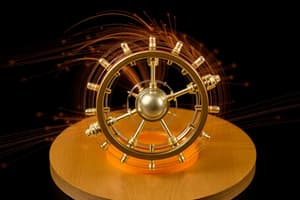Podcast
Questions and Answers
Which law relates the magnetic field to the current flowing through a conductor?
Which law relates the magnetic field to the current flowing through a conductor?
- Ampere's law (correct)
- Biot-Savart law
- Gauss's law
- Maxwell's equations
What is the primary focus of optics?
What is the primary focus of optics?
- Electromagnetic fields
- Study of wave-particle duality
- Atomic structure
- Behavior of light (correct)
What does the Heisenberg uncertainty principle state?
What does the Heisenberg uncertainty principle state?
- Both position and momentum cannot be known precisely at the same time (correct)
- The speed of light is variable
- Energy levels are continuous
- Particles cannot exhibit wave-like behavior
Which phenomenon describes the bending of light as it travels through different media?
Which phenomenon describes the bending of light as it travels through different media?
What is one of the consequences of special relativity?
What is one of the consequences of special relativity?
Which statement best describes general relativity?
Which statement best describes general relativity?
What defines quantization in quantum mechanics?
What defines quantization in quantum mechanics?
What does diffraction refer to in the context of light waves?
What does diffraction refer to in the context of light waves?
What does Newton's first law of motion state?
What does Newton's first law of motion state?
According to the second law of thermodynamics, what can be said about the entropy of an isolated system?
According to the second law of thermodynamics, what can be said about the entropy of an isolated system?
Which equation represents Newton's second law of motion?
Which equation represents Newton's second law of motion?
Which of the following best defines thermal equilibrium as stated in the zeroth law of thermodynamics?
Which of the following best defines thermal equilibrium as stated in the zeroth law of thermodynamics?
What does Coulomb's law describe?
What does Coulomb's law describe?
In classical mechanics, which of the following concepts relates to the change of position of an object over time?
In classical mechanics, which of the following concepts relates to the change of position of an object over time?
Which principle is illustrated by the statement 'for every action, there is an equal and opposite reaction'?
Which principle is illustrated by the statement 'for every action, there is an equal and opposite reaction'?
What does the first law of thermodynamics emphasize regarding energy?
What does the first law of thermodynamics emphasize regarding energy?
Flashcards
Classical Mechanics
Classical Mechanics
The branch of physics that describes the motion of macroscopic objects, based on Newton's laws of motion.
Velocity
Velocity
A measure of how fast an object's position changes.
Acceleration
Acceleration
The rate of change of velocity over time.
Inertia
Inertia
Signup and view all the flashcards
Friction
Friction
Signup and view all the flashcards
Thermodynamics
Thermodynamics
Signup and view all the flashcards
Internal Energy
Internal Energy
Signup and view all the flashcards
Entropy
Entropy
Signup and view all the flashcards
Gauss's Law
Gauss's Law
Signup and view all the flashcards
Biot-Savart Law
Biot-Savart Law
Signup and view all the flashcards
Ampere's Law
Ampere's Law
Signup and view all the flashcards
Maxwell's Equations
Maxwell's Equations
Signup and view all the flashcards
Optics
Optics
Signup and view all the flashcards
Reflection
Reflection
Signup and view all the flashcards
Quantum Mechanics
Quantum Mechanics
Signup and view all the flashcards
Study Notes
Classical Mechanics
- Classical mechanics describes the motion of macroscopic objects.
- It is based on Newton's laws of motion.
- These laws relate force, mass, and acceleration.
- Newton's first law states that an object at rest stays at rest and an object in motion stays in motion with the same speed and in the same direction unless acted upon by an unbalanced force.
- Newton's second law states that the acceleration of an object is directly proportional to the net force acting on it and inversely proportional to its mass. F = ma.
- Newton's third law states that for every action, there is an equal and opposite reaction.
- Classical mechanics is useful for describing the motion of objects in everyday life.
- It has limitations in describing the motion of objects at very high speeds or very small scales, where relativistic or quantum effects become important.
- Concepts include: velocity, acceleration, momentum, force, energy, work, and power.
- Equations of motion describe how the position of an object changes over time, incorporating initial conditions and forces acting on the object.
Thermodynamics
- Thermodynamics deals with heat, work, and energy transfer.
- It describes the macroscopic properties of systems composed of a large number of particles.
- Key concepts include temperature, heat, internal energy, entropy, and the laws of thermodynamics.
- The zeroth law of thermodynamics defines thermal equilibrium.
- The first law of thermodynamics states that energy can neither be created nor destroyed, only transferred or changed from one form to another. ΔU = Q - W. (Change in internal energy is equal to heat added minus work done).
- The second law of thermodynamics states that the total entropy of an isolated system can only increase over time, or remain constant in ideal cases of reversible processes.
- The third law of thermodynamics states that the entropy of a perfect crystal at absolute zero temperature is zero.
- Applications include the design of engines, refrigerators, power plants, and other thermal devices.
- Concepts like heat engines, refrigerators, Carnot cycle are central to thermodynamic investigations.
Electromagnetism
- Electromagnetism describes the interactions between electric charges and magnetic fields.
- It is a fundamental force of nature.
- Key concepts include electric charge, electric field, electric potential, magnetic field, and electromagnetic waves.
- Coulomb's law describes the force between two point charges.
- Gauss's law relates the electric field to the enclosed charge.
- Biot-Savart law describes the magnetic field due to a current-carrying wire.
- Ampere's law relates the magnetic field to the current.
- Maxwell's equations unify electricity, magnetism, and optics into a single framework.
- Electromagnetism is responsible for a vast array of phenomena, from light to electric motors and radio waves.
Optics
- Optics deals with the behavior of light.
- It involves the study of reflection, refraction, diffraction, and interference of light waves.
- Key concepts include wavefronts, rays, reflection angles, Snell's law, and lenses.
- Reflection and refraction describe how light bounces off surfaces and bends as it passes through different media respectively.
- Diffraction describes the spreading of light waves as they pass through an aperture or around an obstacle.
- Interference involves the interaction of multiple light waves, resulting in constructive or destructive interference patterns.
- Lenses and mirrors are optical devices that manipulate light beams to produce various effects, including image formation.
- Different types of light sources like lasers, LEDs are key topics.
Quantum Mechanics
- Quantum mechanics describes the behavior of matter and energy at the atomic and subatomic level.
- It differs significantly from classical mechanics at these scales.
- Key concepts include quantization, wave-particle duality, uncertainty principle, and quantum states.
- Quantization means that physical properties like energy and angular momentum are not continuous but rather exist only in discrete values.
- The wave-particle duality of matter implies that particles can exhibit wave-like properties and vice-versa.
- The Heisenberg uncertainty principle states that it is impossible to know both the precise position and momentum of a particle simultaneously.
- Quantum mechanics is essential for understanding atomic structure, chemical bonding, and nuclear processes.
Relativity
- Relativity describes the relationship between space and time.
- Developed by Einstein, it encompasses special and general relativity, which challenge Newtonian mechanics at high speeds and strong gravitational fields, respectively.
- Special relativity deals with the motion of objects and the nature of space and time in the absence of gravity.
- Time dilation and length contraction are consequences of special relativity.
- General relativity describes gravity as a curvature of spacetime caused by mass and energy.
- Gravitational time dilation and gravitational lensing are key predictions of general relativity.
Studying That Suits You
Use AI to generate personalized quizzes and flashcards to suit your learning preferences.




